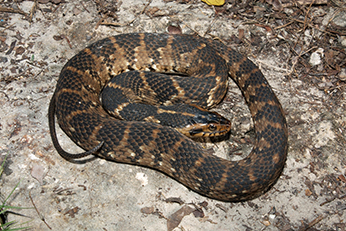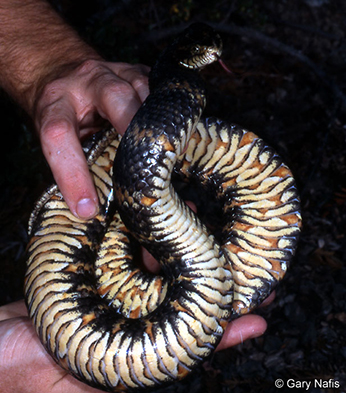(Nerodia fasciata)
General Description
 Southern watersnakes have crossbanding down the length of the body and a dark line extending from the eye to the corner of the mouth. Photo by Todd Pierson.
Southern watersnakes have crossbanding down the length of the body and a dark line extending from the eye to the corner of the mouth. Photo by Todd Pierson.
 The ventral side of the southern watersnake is patterned with dark, square or triangular spots, sometimes with wavy cross lines. Sacramento County. Photo by Gary Nafis, California Herps.
The ventral side of the southern watersnake is patterned with dark, square or triangular spots, sometimes with wavy cross lines. Sacramento County. Photo by Gary Nafis, California Herps.
Southern watersnakes are thick-bodied, aquatic snakes that can reach up to 5 feet in length. There are three subspecies of southern watersnake: banded, broad-banded, and Florida. All three subspecies have crossbands that run the entire length of the body and a dark stripe that extends from the eye to the corner of the mouth. Body color of southern watersnakes varies by subspecies and can be black, brown, yellow-brown, tan, gray, or red. Crossband coloration also varies among black, brown, tan, and red. Their undersides are marked with dark, square or triangular spots, sometimes with wavy cross lines. Older southern watersnakes often appear almost entirely dark brown or black in color, as their patterning is hardly visible. Southern watersnakes are not venomous, but when threatened, will strike repeatedly and emit a foul-smelling musk mixed with feces. The populations found in California are believed to be the Florida (N. f. pictiventris) subspecies.
Current Distribution
In California, southern watersnakes are found in Sacramento, Yolo, and Los Angeles counties. They have established in the Sacramento River watershed south of Sacramento, within a constructed marsh in Folsom, and near Lake Natoma, a reservoir along the American River. Southern watersnakes have also been established in Machado Lake in Harbor City, CA, since 2006. Additionally, introduced populations of southern watersnakes are present in Cameron County, Texas, and have likely been established there since before the 1950s. Southern watersnakes are native to the southeastern United States; their range encompasses the coastal plain from North Carolina to southern Florida, west to Texas, and north into the Mississippi Valley to southeastern Missouri and southern Illinois.
Habitat Preference
Southern watersnakes live in most types of permanent freshwaters such as ponds, lakes, wetlands, marshes, swamps, wet prairies, canals, and slow-moving streams and rivers. They are also occasionally found in brackish water at the edge of mangrove swamps and saltwater meadows and marshes. Southern watersnakes bask in the sun on the banks of waterbodies in vegetation or on logs and overhanging limbs, and retreat to bankside burrows and vegetative debris for shelter. Southern watersnakes are able to travel overland for a mile or more, if needed, to search for food.
Pathways
Though watersnakes are not uncommon in the pet trade, their ill temperament and unpleasant smell make them poor pets, making intentional or accidental release of pets the most likely pathway of Nerodia introductions into California and other non-native areas. Southern watersnakes are believed to have been introduced into Texas through importation by a local snake dealer and their subsequent escape during a hurricane. In 2008, all species of the genus Nerodia were listed as restricted species in California, and thus cannot be imported, transported, or possessed without a permit.
Impacts
Southern watersnakes are generalized predators that eat a variety of animals, including worms, crustaceans, amphibians, small fish, turtles, birds, and other snakes. This diet, combined with their adaptability to a variety of freshwater habitats, high reproductive rate, tolerance for brackish water, and ability to disperse overland, allows southern watersnakes to successfully prey upon and out-compete native animal species for space and resources where they are introduced. In northern California, introduced watersnakes are a threat to the state and federally threatened giant garter snake (Thamnophis gigas), which is dependent upon wetland habitat and native fish and amphibians for food.
Actions Taken if Found
If you observe this species in California, please report your sighting to the CDFW Invasive Species Program, by email to Invasives@wildlife.ca.gov. If you catch, or are currently in possession of a watersnake, do not release it. Immediately contact the CDFW Invasive Species Program at (866) 440-9530 for assistance.
Additional Resources